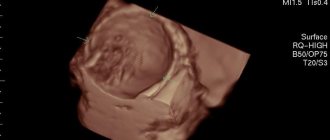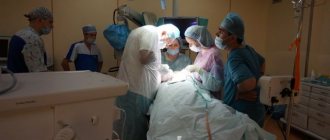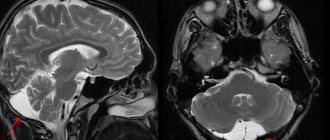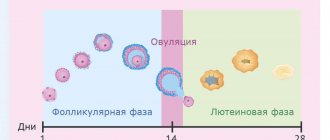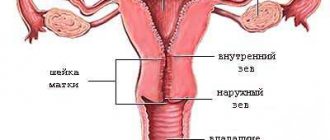Paraovarian ovarian cyst is a benign cavity tumor formed from the tissue of the ovarian appendage. The pathology occurs when embryogenesis is disrupted and is diagnosed mainly in women of reproductive age, much less often in the puberty period. At the initial stages of development, the tumor does not cause any pathological symptoms, but as the tumor increases in size, the woman is first bothered by aching, then sharp pain, menstrual irregularities, diuretic disorders, etc. If there is no treatment for paraoviral ovarian cyst, it is complicated by torsion of the pedicle, infection and capsule rupture. Therefore, if there are suspicious symptoms, it is necessary to visit a gynecologist as soon as possible, be examined and immediately begin therapy. Timely treatment of gynecological pathology significantly improves the prognosis for successful recovery.
What is a paraoviral ovarian cyst?
A paraovial cyst occurs during the embryonic formation of the fetus. The disease is not hereditarily determined, therefore it is not inherited. The tumor forms between the layers of the broad ligament of the uterus, as well as between the tube and the appendage. Since the ovary begins to actively develop during puberty and reaches its maximum during puberty, such a cyst often appears in women aged 20 to 45 years.
A paraovial cyst has a benign etiology and never degenerates into cancer. The increase in the size of the formation occurs due to the filling of the capsule with liquid and stretching of its walls. A distinctive feature of a cyst is that it does not resolve either spontaneously or with conservative treatment. Therefore, if dynamic growth of the tumor is observed, the doctor suggests removing it surgically.
An increase in paraovial cystic formation occurs for the following reasons:
- inflammation of the ovaries and uterine appendages;
- early puberty;
- numerous abortions;
- sexually transmitted infections;
- uncontrolled use of hormonal drugs;
- endocrine and hormonal disorders;
- pregnancy.
Cystoma
Cystoma is an enlarging tumor, often having a multi-chamber cavity. Growth occurs both due to the accumulation of fluid inside the cavity and as a result of the division of cells that make up the formation. This tumor is real. Can be benign, malignant or potentially malignant.
There are groups of patients whose risk of developing cysts is especially high:
- patients with chronic diseases of the genital area, as an addition to complex therapy, such women are recommended to use hormonal contraceptives;
- patients with hormonal disorders: lack of pregnancy (hormonal infertility), disrupted menstrual cycle;
- patients who have undergone ovarian surgery, incl. cystectomy;
- Bad heredity – endometriosis and ovarian tumors in the family;
- Patients with breast cancer;
- Women who have had a pathological pregnancy.
There are difficulties in finding screening - identifying certain signs in many patients. It is necessary to conduct an in-depth examination of women if there is a formation larger than 3 cm on the uterine appendages during a two-hand examination.
Characteristic
Depending on the location of the pathology, a paraovial cyst can be:
- right-sided;
- left-handed.
Tumors are classified according to size:
- Small - up to 2.5 cm without stem. They occur without characteristic signs and do not cause any complications.
- Large - more than 5 cm. They can form a pedicle, which consists of an ovary or fallopian tube. The presence of a stalk can lead to serious complications, as it can twist, causing inflammation and suppuration of the contents of the capsule.
Treatment in preparation for the ART program
The presence of an ovarian cyst, as a rule, is a contraindication to the use of assisted reproductive technologies. It is recommended to start the program upon completion of treatment.
Follicular and luteal cysts are subject to observation or conservative treatment. Tactics are determined taking into account the medical history, the size of the tumor, and the presence of symptoms. Conservative therapy involves the use of hormonal agents. If there is no effect, large functional cysts are removed.
Organic types of cysts are subject to surgical treatment. In preparation for ART, operations are performed as planned using low-traumatic laparoscopic techniques. The implementation of the program begins after the completion of the rehabilitation period.
Symptoms of a paraovarian cyst
Symptoms of a paraovarian ovarian cyst depend on its size and location. A formation up to 5 cm in size does not manifest itself in any way; a woman may not even be aware of her disease, leading her usual lifestyle.
If the cyst has reached a large size - more than 50 mm, pathological symptoms begin to worry:
- Bursting, aching, nagging pain in the lower abdomen, radiating to the lower back, perineum, and inner thigh.
- The pain syndrome is often not associated with the menstrual cycle, intensifies after physical activity, and resolves spontaneously.
- Dysuric disorders associated with compression of the growing tumor of the bladder and intestines. A woman complains of an increased urge to urinate, frequent constipation or, conversely, diarrhea and bloating.
- Irregularities in the menstrual cycle, accompanied by a decrease or increase in bleeding.
- Acute pain during intimacy.
Another characteristic sign of such gynecological pathology is acute abdominal syndrome, which is characterized by severe, sometimes unbearable pain and indicates the development of dangerous complications requiring immediate medical intervention.
Types of ovarian cysts: their signs and symptoms
By their nature, ovarian cysts are functional and organic.
Functional ovarian cysts
Functional cysts include follicular cysts and corpus luteum cysts; most often they spontaneously resolve within several menstrual cycles. If functional cysts are small in diameter, do not put pressure on surrounding organs and do not cause pain, they are usually not treated. For large cysts, hormonal treatment is carried out; most often, hormonal contraceptives are prescribed, which normalize hormonal levels and promote the resorption of the cyst.
Functional cysts, as a rule, do not have an effect on the course of pregnancy. When pregnancy occurs, they usually resolve before 16-19 weeks.
In addition, at short stages of pregnancy, the doctor very often diagnoses the presence of a corpus luteum cyst, which promotes pregnancy due to the increased production of progesterone (pregnancy hormone). Such cysts decrease in size and resolve after the placenta has formed, that is, after 12 weeks of pregnancy.
Organic ovarian cysts
Organic cysts are cysts that do not resolve on their own and most often require surgical treatment. These include endometrioid cysts, cystadenomas, dermoid and paraovarian cysts.
Endometrioid cysts
These are benign organic cysts, they grow slowly and are easily treated surgically. Inside them is endometrial tissue, the inner lining of the uterine cavity, which changes monthly and is shed during menstruation.
The endometrium is a hormonal-dependent tissue; accordingly, all the same processes take place inside the cyst as in the uterine cavity, that is, the endometrium grows in the first phase of the menstrual cycle, matures in the second phase and is rejected with bleeding during menstruation. Due to these processes, there is a gradual increase in the diameter of the endometrioid cyst.
Most often, small endometriotic ovarian cysts are asymptomatic and are accidentally found during ultrasound. Large cysts can cause pain that worsens during menstruation. They are often double-sided and can reach significant sizes. Endometrioid cysts have a small risk of degenerating into a malignant ovarian cyst, most often occurring in women over 40 years of age.
The presence of endometrioid ovarian cysts can prevent pregnancy and is an indication for surgical treatment. First, the cyst is removed, and then hormonal therapy is performed, since endometrioid cysts are prone to reappearing. The most commonly prescribed drugs are hormonal contraceptives and medications that induce artificial menopause. In the absence of hormonal stimulation, endometrioid cells die, which prevents the recurrence of the disease. Depending on the diameter and number of endometrioid cysts, the presence of foci of endometriosis on the fallopian tubes and internal tissues of the abdominal cavity, a drug is selected.
Cystadenomas
This is a fairly common type of ovarian cyst; most often cystadenomas are unilateral small cysts. Depending on the contents, a distinction is made between serous cystadenoma, which contains a clear, light-straw-colored liquid, and mucinous cystadenoma, with thick mucus inside.
Cystadenomas
These are benign cysts, but they can become malignant, which determines the tactics of their treatment: surgical removal of the formation.
During pregnancy, cystadenomas can increase in volume and cause constant abdominal pain.
Dermoid cyst (mature teratoma)
This is a congenital tumor of the ovary, it is a round formation in the ovary and contains in its structure elements of hair, skin, nails, and fat. Such cysts can be of different sizes - from a few centimeters to giant formations. However, most often they are small and therefore do not manifest themselves clinically. Small dermoid cysts, as a rule, do not have an effect on conception and pregnancy; however, since there is a small probability of malignant degeneration of teratomas, their treatment is surgical.
Paraovarian cysts
This is a fluid-filled formation that is located between the ligaments of the uterus, next to the ovary. A paraovarian cyst is most often small in size and does not shrink over time or under the influence of medications. However, it may increase. Most often this occurs due to prolonged overheating - for example, if a woman likes to visit the sauna, abuses body wraps, and often takes baths with a water temperature of more than 38 degrees C. The progression of a paraovarian cyst is also facilitated by tanning under the sun or in a solarium.
This type of formation, when small in size, usually does not affect the course of pregnancy and does not require any treatment. If the cyst is actively growing, surgical removal is indicated.
Diagnostics
A gynecologist diagnoses and treats paraovial cysts. You should urgently make an appointment with him if you have characteristic symptoms of the pathology. But most often the disease is diagnosed during a routine ultrasound, since in the initial stages of development it is asymptomatic.
After analyzing complaints and collecting anamnesis, the doctor conducts a bimanual gynecological examination, during which a paraovial ovarian cyst on the right or left is clearly palpated. The tumor is characterized by limited mobility, has smooth contours, and an elastic consistency.
To confirm the diagnosis, diagnostic procedures such as:
- Transvaginal ultrasound examination. During diagnosis, a round, thin-walled neoplasm with homogeneous anechoic content is visualized on the monitor screen.
- Laparoscopy. A minimally invasive diagnostic procedure performed using an optical laparoscope through punctures in the abdominal wall. By moving the laparoscope, the doctor examines the external contours of the uterine body, ovarian tissue, and the pelvic cavity.
A differential diagnosis must be carried out, which excludes pathologies such as:
- ectopic pregnancy;
- ovarian cyst;
- true ovarian tumor.
Prevention
The best prevention for the development of ovarian cysts is periodic examinations by a gynecologist and a transvaginal ultrasound to assess the condition of all organs of the female reproductive system. Every six months, every woman needs to visit a gynecologist to avoid the development of not only cysts, but also other diseases, including cancer.
Timely consultation with a doctor helps to identify the disease at the earliest stages and begin treatment immediately.
In addition, a woman should avoid excessive stress and sports activities, which disable the hormonal system and can trigger the development of ovarian cysts. Take care of your health, and if unpleasant symptoms appear, trust a specialist.
Gynecologists at MC “Health” are ready to help patients with any problems in maintaining women’s health. An ovarian cyst of any kind is not a death sentence. Our specialists will conduct a full examination, determine the type of cyst and prescribe appropriate treatment as soon as possible.
Paraovarian ovarian cyst on the left
A tumor that forms on the left ovary is called a left paraovial cyst. The neoplasm can reach impressive sizes, is attached to the base with a pedicle, but can develop without it.
Paraovarian ovarian cyst on the left is diagnosed much less frequently than on the right. It does not have a clear clinical picture and is often detected during a routine diagnostic examination. When the size of the tumor reaches 9 centimeters or more, it compresses the surrounding tissue. Soon the woman begins to be bothered by a frequent urge to urinate and causeless constipation.
What studies are carried out for ovarian tumors
- Bimanual examination remains relevant even with the most modern equipment, as it allows one to obtain important information.
- Speculum examination provides access to the cervix for examination, allows you to take aspirate and examine the endometrium.
- Washing and puncture of the abdominal cavity for cytological examination.
- Ultrasound using vaginal and abdominal sensors.
- Nuclear MRI and computed tomography allow for precise layer-by-layer studies to identify the presence of metastases in the lymph nodes.
- Ultrasound and mammography - examination of the mammary glands.
- Study of the condition of the endometrium.
- Examination of the intestine for the presence of a tumor (irrigoscopy, rectromanoscopy).
- Examination of the gastrointestinal tract, since the appearance of a metastatic tumor in the pancreas, intestines, and stomach is possible.
- Tumor markers. Increase in tumor marker CA-125 - more than 35 units. indicates an increased risk of developing an oncological process. But this statement is not always true, since there are cases where a significant excess of the tumor marker norm in endometrial ovarian cysts and endometriosis is not related to oncology.
- Carrying out laparoscopy
Paraovarian ovarian cyst on the right
Paraovarian cyst of the right ovary is diagnosed more often than the left. This is due to the anatomical features of the appendage and the more intense blood supply to its tissues. Symptoms of a right-sided cystic tumor are more pronounced. Due to increased nutrition, it grows much faster, causing serious complications in advanced cases. The progression of the disease is accompanied by acute pain in the lower right segment of the abdominal cavity, disturbances in the functioning of the intestines often occur, the abdomen becomes asymmetrical and enlarges on the right side.
Cyst. Lead tactics
The cyst is observed for 2 months. If positive dynamics are not recorded, the issue of surgery is decided. Such formations do not disappear on their own, there are no medications for treatment, and traditional methods will not help.
If the formation is small, you can simply observe it, but over time the cyst must still be removed.
If a cyst is detected, a cystectomy is performed - the formation is removed along with the capsule to prevent recurrence. Modern capabilities (laparoscopy) make it possible to do this without damaging healthy ovarian tissue. The paraovarian cyst is removed with minimal intervention. In case of complications, surgery is also indicated.
Complications of paraovarian cyst
Increased physical activity, sudden changes in body position, and excessive sun exposure can provoke severe complications of the cyst:
- leg torsion;
- content infection;
- capsule rupture.
Torsion of the leg causes compression of the uterine ligaments, as well as nervous and vascular structures. This leads to necrosis of the cystic formation, which is accompanied by a sharp deterioration of the condition:
- intense spasms that surround the entire abdominal cavity;
- tension of the anterior abdominal wall;
- excessive gas formation;
- a drop in blood pressure and an increase in heart rate;
- paleness of the skin;
- weakness, up to loss of consciousness.
Suppuration of a cyst is often caused by the penetration of pathogenic microflora into its cavity, spreading throughout the body through the lymphogenous or hematogenous route from a distant source of infection. Characteristic symptoms of progression of purulent processes:
- fever and temperature rise to critical values of 38 – 39 °C;
- severe intoxication;
- sharp pain in the lower abdomen;
- weakness, lethargy.
Rupture of a paraovial cyst leads to a state of shock and is accompanied by unbearable pain and internal bleeding. Any complications of the pathology require emergency surgical care, otherwise the situation can be fatal.
Causes of cysts
There are a large number of etiological factors for the occurrence of such neoplasms on the ovaries. Often they are already formed before pregnancy. the influence of the gestation period on the formation of ovarian cysts has not been proven.
The causes of the development of ovarian cysts are:
- Sexually transmitted infections. Acute and chronic pelvic inflammatory diseases can provoke the growth of formations on the ovaries.
- Hormonal disorders. Various hormonal imbalances can lead to the formation in most cases of functional ovarian cysts (follicular cysts, corpus luteum cysts). When hormonal levels are normalized, small cysts can be eliminated on their own.
- Abortion. Regardless of how the pregnancy was terminated, abortion is a huge stress for the body. This is a hormonal surge against the background of an abruptly interrupted pregnancy. and, of course, such a factor can cause hormonal imbalance, which causes the formation of ovarian cysts.
- Genetic predisposition. A history of ovarian cysts in close relatives increases the likelihood of the formation of such a pathological process.
- Long-term absence of pregnancy and constant work of the ovaries, constant ovulation are a traumatic factor. After all, follicles grow, mature and rupture every month. Lack of pregnancy and failure to take combined oral contraceptives increase the risk of ovarian cysts.
Treatment of paraovarian cyst
Paraovial cysts are not prone to self-resorption and often become complicated, so the doctor will recommend surgical treatment of the tumor. Removal of the tumor is carried out in two ways:
- Laparoscopy. A gentle, minimally invasive surgical operation, during which all manipulations are performed through 2 small punctures in the wall of the abdominal cavity. An optic is inserted into one hole, and a surgical instrument is inserted into the second. Under video surveillance control, the surgeon excises the pathological neoplasm and affected tissue.
- Laparotomy. This is a radical traumatic operation that involves dissecting the anterior wall of the peritoneum and performing all manipulations through the incision. Laparotomy is prescribed for cyst rupture and heavy bleeding.
After surgical treatment, relapses of the paraovial cyst do not occur, since it is formed only during intrauterine development from embryonic tissue.
Lead tactics
- Surgery for a malignant ovarian tumor.
The uterus and cervix, appendages, as well as the greater omentum are removed. Removing the oil seal is important because... In some cases, it contains micrometastases. In addition, the omentum promotes the production and accumulation of ascityl fluid.
- Surgery for a benign tumor
Adnexectomy is performed - removal of appendages. Simultaneously with surgical treatment:
- the internal lining of the formation is examined in detail for malignant growths;
- Histological examination is performed.
A modern approach to diagnosing and treating cysts and other diseases of the female genital area is offered by gynecologists at the RAS clinic in Moscow. Here you can undergo a preventive examination by a gynecologist and have a pelvic ultrasound performed. You can make an appointment for a consultation on the website or by calling the numbers provided.
Cost of treatment for paraovarian ovarian cyst
The cost of therapy depends on the complexity of the disease, the therapeutic methods used, and the presence of associated complications. Our doctors will conduct a quick and highly accurate diagnosis and select the most effective treatment regimen using gentle, organ-preserving surgical methods. Our multidisciplinary clinic has the most adequate price-quality ratio.
To clarify the cost of treatment for gynecological pathology and make an appointment with a specialist at the Healthy Family clinic, call the number or request a call back. As soon as the managers see the request, they will immediately contact you, advise on all issues of interest and agree on a time convenient for you.
Methods of carrying out operational actions
Laparoscopic removal
Laparoscopy involves the removal of ovarian cysts through three or four small incisions. Initially, the abdominal cavity is examined, after which the neoplasm itself is monitored. The final stage is liquidation. The operation to remove an ovarian cyst is performed under anesthesia, and the duration varies from half an hour to 60 minutes.
laparoscopy of ovarian cysts
This operation is carried out using special medical equipment - a laparoscope. It is equipped with special mechanisms, which helps to obtain high-quality images of internal organs.
Types of laparoscopy for ovarian cysts :
- Scrape out formations without damaging tissue. This surgical treatment is called cystectomy.
- Removal of a specific component of the ovary where the cyst is located.
- Removal of the tumor and ovary is called oophorectomy. It is worth noting that this operation is characterized by preservation of the pipe.
- Adnexectomy is the removal of the ovary and tube from the side of the injury.



